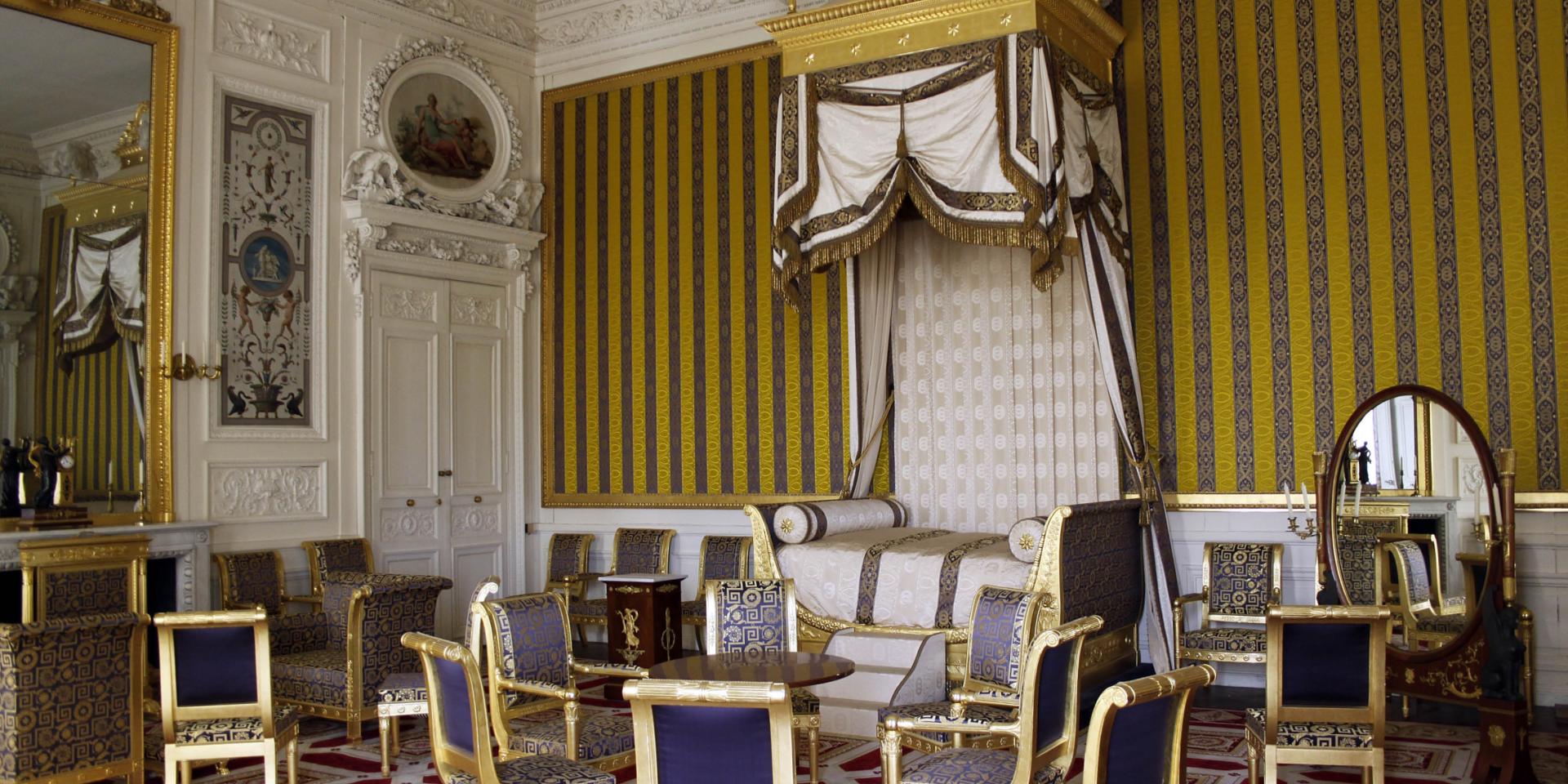The King of Rome’s Apartment was fitted out under Napoleon I in the former apartment of Queen Marie-Antoinette. Referred to as Apartment A during the July Monarchy, it was occupied by distinguished guests such as the Duke of Orleans, eldest son of King Louis-Philippe, and, during the Second Empire, Princess Mathilde, Napoleon III’s cousin.
On 22 October 1807, Louis-Martin Berthault, head architect at Compiègne, presented Napoleon Bonaparte with plans for the interior renovation of the castle. The emperor would determine the outline of a new layout, handing over the former apartment of Queen Marie Antoinette to the use of a foreign sovereign and “making it the most sumptuously furnished part of the house”. Indeed, it went on to welcome the King of Spain, Charles IV, who was forced to abdicate in 1808, and later Louis, King of Holland, and the Emperor’s brother and his wife, Queen Hortense. However, following his birth the apartment was later reserved to the King of Rome. He stayed there during his royal stay of 1811 when he was just a few months old.
In 1814, Louis XVIII, who had returned from exile, chose to stay in this apartment during his visit to Compiègne on the way to Paris. Following that, until the end of his reign, it became the apartment of Monsieur, Frère du Roi (the King’s brother), Louis XIV. Under the reign of Charles X, it would become that of the Duke and Duchess of Angoulême; becoming apartment A during the July Monarchy, it was occupied by the Duke of Orléans. It is also here where foreign sovereigns and princess Mathilde were accommodated during the Second Empire.
- Visit the museums
- Guided Tours
These visits are carried out by speakers from the Réunion des Musées Nationaux (extra charge in addition to entry fee)
Salon des Noces |
|
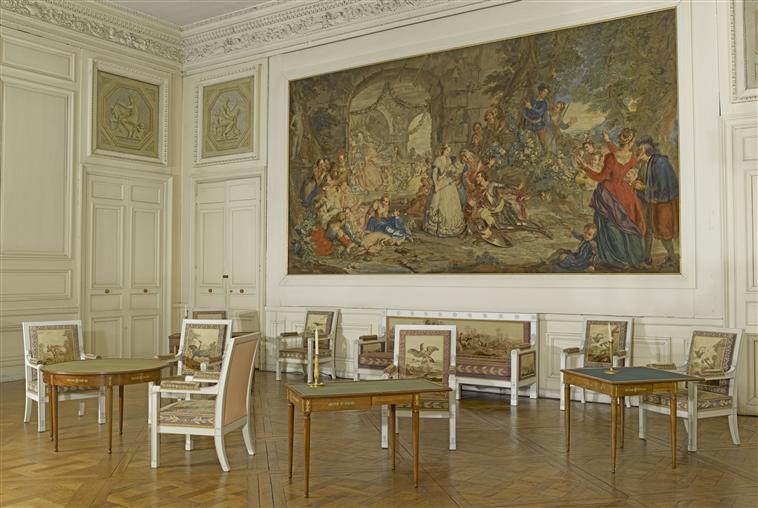
|
The former Salle des Nobles in Marie-Antoinette’s apartment in the 18th century, the room has retained its décor of floor-to-ceiling wood panelling and its grisaille overdoors painted by Sauvage on the theme of the Muses. This salon takes its name from the tapestry hung there in 1808 representing The Marriage of Angélique. Based on a cartoon by Charles-Antoine Coypel, it was woven at the Gobelins factory between 1790 and 1805. It is part of the hanging of the Fragments of Opera inspired by Quinault’s Roland (late 17th century). The painted wood furniture is by Pierre-Benoît Marcion, and the seats are upholstered with Beauvais tapestry inspired by La Fontaine’s Fables.
|
Queen’s Games Parlour |
|
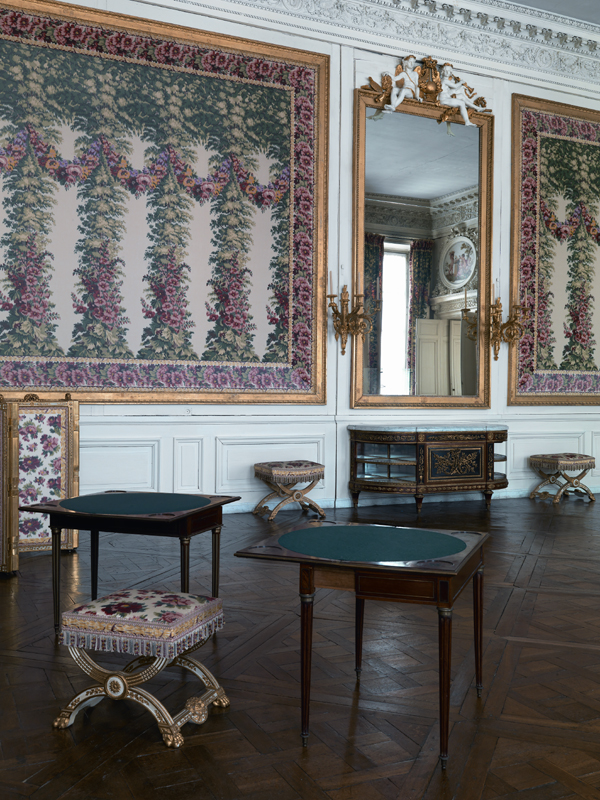
|
Restored to its late 18th-century appearance, this room, which later became the Second salon of the King of Rome’s apartment, is all that remains of Marie-Antoinette’s apartment. But neither Louis XVI nor the Queen ever saw their apartments completed and furnished due to the French Revolution. The décor designed by Le Dreux de La Châtre features white-painted floor-to-ceiling wood panelling, a large sculpted frieze, the white marble fireplace and ornamental sculptural elements above the mirrors and doors by Randon, originally from Crépy-en-Valois, while Beauvallet, who trained in Paris, designed the putti with legs dangling and eagles with wings spread, an allusion to the Austrian origin of the queen and not an Empire addition. The overdoors, painted "in colour" by Sauvage and added in 1789, represent the Four Elements (fire, water, air and earth), symbolised by children's games. The wall hanging, consisting of two panels, brings colour to this décor with matching curtains: "Gros de Tours ribbed taffeta" with tree, bower and hollyhock motifs, commissioned from Pernon in 1785, woven in Lyon and delivered the following year. This silk was rewoven in Lyon in accordance with the original model. The gilded wood furniture with white highlights originally comprised 40 ployants and 12 stools. Like the fire screen and the six-leaf screen, it was produced under the direction of Hauré, head of furniture manufacturing at the Royal Garde-Meuble from 1785 to 1788. The two large chests of drawers, each with a central panel concealing three drawers and corner shelves, are the work of the cabinetmaker Bennemann, under Hauré’s direction. Delivered in 1786, they are inspired by a chest of drawers by Stöckel made for the Queen's bedchamber in Saint-Cloud. Adorned in the centre with the queen's monogram, they present a rich floral decoration of gilded bronzes by Tournay and Galle, inspired by nature and Antiquity. The deer and boar wall lights in the Greek style of the 1770s are by Pitoin, sculptor, master-founder and gilder. The quiver-shaped wall sconces, scrolls of plants and garlands of flowers and fruits added in 1787 were designed by Martin and carved and mounted by Thomire.
|
The King of Rome’s Bedchamber |
|

|
As with the previous room, and in view of its importance, the former bedchamber of Marie-Antoinette has retained its original lavish sculpted décor: putti above the mirrors and eagles over the doors. The overdoors, painted "in colour" by Sauvage, represent the Four Seasons symbolised by children and female figures. Under the Empire, the queen’s monogram in this décor were replaced with that of Napoleon, and four panels were added with arabesque motifs in the Pompeian style. These were produced by the painters Dubois and Redouté on the theme of the Story of Psyche. From left to right: Psyche opening the Box sent by Proserpine, Psyche consoled by Cupid, The Toilette of Psyche, and Psyche awakening Cupid. The profusion of gilding matches the sumptuousness of the fabrics: "gold brocade with daffodil yellow and blue stripes, palmettes and Turkish designs". All the gilded wood furniture was supplied by Pierre-Benoît Marcion. According to the Ancien Régime tradition, the series of chairs included six wider “sièges meublants” to be placed along the walls, and six “sieges courants” used to sit on.
|
Boudoir |
|
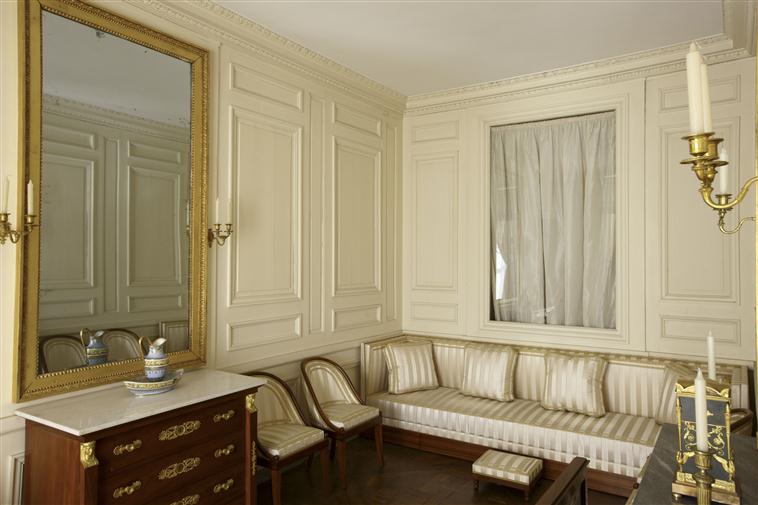
|
From this room, one entered the queen’s private apartments, hence the succession of rooms with lower ceilings - the result of a mezzanine. The 2-way mirror opposite the windows was designed to reflect natural light into a rear study. This room is an exception in the King of Rome’s apartment: it is simply furnished with mahogany, having retained the initial furnishings of 1808 used by Charles IV, King of Spain. The small chest of drawers, which could be used as a writing desk, is the work of Marcion, while the small gondola chairs are made by Jacob-Desmalter.
|
Bathroom |
|
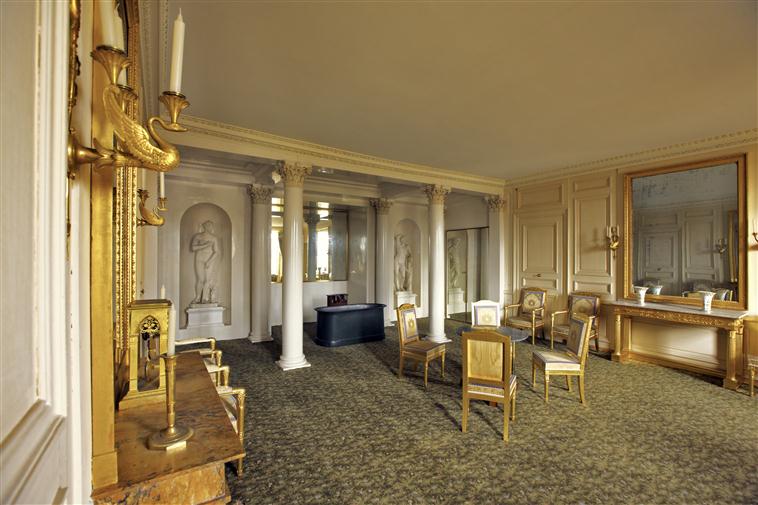
|
The King of Rome’s bathroom, radically altered during the Second Empire, has been restored to its First Empire appearance. The far end of the room with its "white stucco statuary" décor is reserved for bathing. Four columns with Corinthian capitals frame the bronze-green, glazed iron bath with gooseneck taps. In the alcoves are casts of antiques: on the left, the Medici Venus, and on the right, the Apollino. The front section of the room serves as a sitting room; the gilded wood furniture is by Marcion.
|
Salon-boudoir |
|

|
This corner room is the last in the queen's former private apartment and that of the King of Rome. It holds particular historical significance: in April 1814, King Louis XVIII, returning from England, stopped briefly at Compiègne. He occupied this apartment, not wanting to stay in the Emperor’s apartment, which was decorated with imperial emblems. It was here that he held his political meetings in preparation for his return to Paris. All the gilded wood furniture in this room was supplied by Marcion, and the seats are upholstered in "blue damask, with a motif of vases and gold-coloured shields".
|

